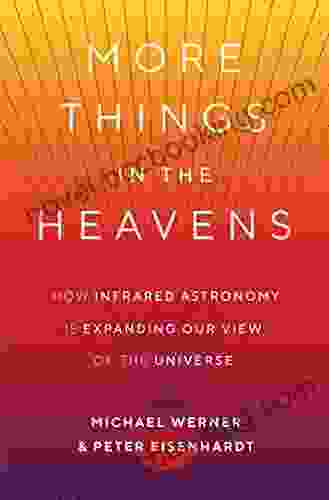How Infrared Astronomy Is Expanding Our View Of The Universe

4.6 out of 5
| Language | : | English |
| File size | : | 76283 KB |
| Text-to-Speech | : | Enabled |
| Screen Reader | : | Supported |
| Enhanced typesetting | : | Enabled |
| Word Wise | : | Enabled |
| Print length | : | 298 pages |
Infrared astronomy is a rapidly growing field that is providing new insights into the universe. It allows us to see objects that are too cold to emit visible light, such as planets, stars, and galaxies. Infrared astronomy has also helped us to understand the formation and evolution of the universe, and to discover new objects, such as black holes.
The History of Infrared Astronomy
The history of infrared astronomy dates back to the early 19th century. In 1800, Sir William Herschel discovered infrared radiation when he was studying the Sun. Herschel used a prism to disperse the Sun's light, and he noticed that there was a region of the spectrum beyond the visible light that was invisible to the human eye. Herschel called this region the "heat rays" because he found that it could heat objects.
In the early 20th century, scientists began to develop infrared telescopes. The first infrared telescope was built in 1955 by Gerald Kuiper. Kuiper's telescope was a small, simple instrument, but it was able to detect infrared radiation from planets, stars, and galaxies. In the years since Kuiper's discovery, infrared telescopes have become much more powerful and sophisticated. Today, there are a number of large infrared telescopes in operation around the world.
The Different Types of Infrared Telescopes
There are two main types of infrared telescopes: ground-based telescopes and space-based telescopes. Ground-based telescopes are located on the Earth's surface, while space-based telescopes are located in space. Each type of telescope has its own advantages and disadvantages.
Ground-based telescopes are less expensive to build and operate than space-based telescopes. They also have a wider field of view than space-based telescopes. However, ground-based telescopes are limited by the Earth's atmosphere, which absorbs infrared radiation. This means that ground-based telescopes can only observe a limited amount of the universe.
Space-based telescopes are not affected by the Earth's atmosphere. This means that they can observe a much wider range of the universe. However, space-based telescopes are more expensive to build and operate than ground-based telescopes. They also have a narrower field of view than ground-based telescopes.
Some of the Exciting Discoveries That Have Been Made Using Infrared Astronomy
Infrared astronomy has led to a number of exciting discoveries, including the discovery of new planets, stars, and galaxies. Infrared astronomy has also helped us to understand the formation and evolution of the universe, and to discover new objects, such as black holes.
One of the most exciting discoveries made using infrared astronomy is the discovery of new planets. In the 1990s, infrared telescopes began to detect planets around other stars. These planets were too small and too cold to be seen using visible light telescopes. However, infrared telescopes were able to detect the heat that these planets emitted. Today, we know of hundreds of planets that orbit other stars, and many of these planets are similar in size to Earth.
Infrared astronomy has also helped us to understand the formation and evolution of the universe. By studying the infrared radiation from galaxies, astronomers have been able to learn about the history of the universe. They have found that the universe is about 13.8 billion years old, and that it has been expanding and cooling ever since the Big Bang. Infrared astronomy has also helped us to discover new objects, such as black holes. Black holes are regions of space where gravity is so strong that nothing, not even light, can escape. Black holes are invisible to visible light telescopes, but they can be detected using infrared telescopes.
The Future of Infrared Astronomy
Infrared astronomy is a rapidly growing field that is providing new insights into the universe. In the future, infrared telescopes will continue to play an important role in our understanding of the universe. Infrared telescopes will be used to study the early universe, to search for new planets, and to understand the nature of black holes. Infrared astronomy is a powerful tool that is helping us to understand our place in the universe.
4.6 out of 5
| Language | : | English |
| File size | : | 76283 KB |
| Text-to-Speech | : | Enabled |
| Screen Reader | : | Supported |
| Enhanced typesetting | : | Enabled |
| Word Wise | : | Enabled |
| Print length | : | 298 pages |
Do you want to contribute by writing guest posts on this blog?
Please contact us and send us a resume of previous articles that you have written.
 Book
Book Novel
Novel Page
Page Chapter
Chapter Text
Text Story
Story Genre
Genre Reader
Reader Library
Library Paperback
Paperback E-book
E-book Magazine
Magazine Newspaper
Newspaper Paragraph
Paragraph Sentence
Sentence Bookmark
Bookmark Shelf
Shelf Glossary
Glossary Bibliography
Bibliography Foreword
Foreword Preface
Preface Synopsis
Synopsis Annotation
Annotation Footnote
Footnote Manuscript
Manuscript Scroll
Scroll Codex
Codex Tome
Tome Bestseller
Bestseller Classics
Classics Library card
Library card Narrative
Narrative Biography
Biography Autobiography
Autobiography Memoir
Memoir Reference
Reference Encyclopedia
Encyclopedia Rajiv Sarma
Rajiv Sarma Ronald G Wayne
Ronald G Wayne Sophie Lockwood
Sophie Lockwood Robert Livingston
Robert Livingston Rob Durham
Rob Durham Stacey Williams
Stacey Williams Sharon M Ravitch
Sharon M Ravitch Renee George
Renee George Rosa Parks
Rosa Parks Rob Meyerson
Rob Meyerson Richard A Swanson
Richard A Swanson Randi Zuckerberg
Randi Zuckerberg Thomas Gilovich
Thomas Gilovich Stephen M Lind Jd Atp
Stephen M Lind Jd Atp John Berger
John Berger Tiziano Bellini
Tiziano Bellini Richard Wake
Richard Wake Russ Baker
Russ Baker Stephen Powell
Stephen Powell Robert E Kapsis
Robert E Kapsis
Light bulbAdvertise smarter! Our strategic ad space ensures maximum exposure. Reserve your spot today!
 Milton BellFollow ·17.1k
Milton BellFollow ·17.1k Steven HayesFollow ·3.1k
Steven HayesFollow ·3.1k Emilio CoxFollow ·3.1k
Emilio CoxFollow ·3.1k Clark CampbellFollow ·4.6k
Clark CampbellFollow ·4.6k Chuck MitchellFollow ·12.6k
Chuck MitchellFollow ·12.6k Kazuo IshiguroFollow ·7.6k
Kazuo IshiguroFollow ·7.6k Herman MitchellFollow ·12.9k
Herman MitchellFollow ·12.9k Dean ButlerFollow ·15.9k
Dean ButlerFollow ·15.9k

 Steven Hayes
Steven HayesEmbark on Unforgettable Adventures: Discover the Best of...
Unveiling the Enchanting Trails of the...

 Jarrett Blair
Jarrett BlairMaster the Road: Ace Your North Carolina Driver's Test...
Unlock the Secrets to...

 Brent Foster
Brent FosterDk Essential Managers Understanding Accounts: Your...
In today's...

 Isaac Mitchell
Isaac MitchellPrognosis: A Memoir of My Brain - A Journey of Hope and...
In 2013, Eve Ensler was diagnosed with a...
4.6 out of 5
| Language | : | English |
| File size | : | 76283 KB |
| Text-to-Speech | : | Enabled |
| Screen Reader | : | Supported |
| Enhanced typesetting | : | Enabled |
| Word Wise | : | Enabled |
| Print length | : | 298 pages |
















